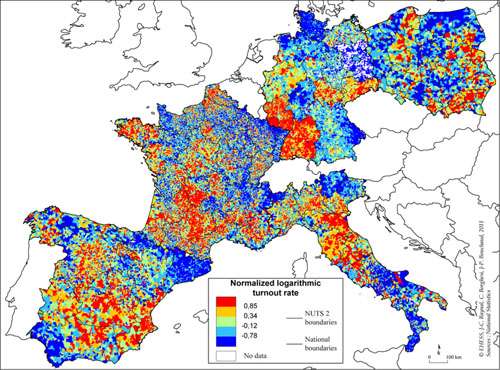Researchers explore elections and voting behaviour with physics

Statistical physics has began to inch itself into the territory of social and human sciences in the past decade. Vast and complex social networks have particularly gained popularity among physicists. Now they have also started to dig into the huge amounts of voting data of elections.
Santo Fortunato, Associate Professor in the Aalto University Department of Biomedical Engineering and Computational Science, presents in an article in the October 2012 issue of Physics Today the latest in physics research on elections. Written together with his Sapienza University of Rome colleague Claudio Castellano, the article introduces statistical and computational methods with which universal and historically persistent features in election performance of candidates and in geographical clustering of turnout rates have been discovered.
Physicists began to research elections in the late 1990s. Fortunato's own work on the subject was sparked by the need to correct and elaborate these early studies. According to Fortunato they did not take the specific characteristics of the proportional electoral system into account. In Physics Today he describes a method with which the influence of parties and their popularity and electoral districts can be included in the analysis of electoral performance.
Candidate performance has a universal dynamic across elections and countries
In Fortunato's and Castellano's own election research, the performance of a candidate is made relative to the average performance of other candidates in the same party. Their data consisted of election results from all over Europe spanning nearly 50 years. A surprising universal feature emerged in candidate performance: the probability density curves describing the likelihood of a given candidate to receive a certain amount of votes were similar in all of the elections studied.
Fortunato takes the recurring phenomenon to show that voting behaviour has dynamics independent from technological development or from changes in economic systems and cultural trends.
"Italy in 1958 and Finland in 2003 were two very different societies; yet the performance of candidates is similarly distributed in both," Fortunato remarks.
The results were also tested by modelling election campaigns as a word-of-mouth process of voting decision-making with variables such as the number of face-to-face contacts between candidates and voters. The model reproduced the results of the actual data.
"With our method the success of candidates can be more reliably measured than with plain absolute performance figures. The actual attractiveness of candidates can be coaxed out of the data as related to the influence of parties and voting districts."
"We model the basic dynamics of voting behaviour. For instance the effect of media on the distribution of candidate performance is of course very difficult to model mathematically. Then again, as physicists we are interested in elections as statistical systems. We are currently analysing new sets of voting data from all around Europe."
Fortunato and Castellano also introduce a recent study of turnout rates and their geographical clustering, carried out by French researchers. Voting data of the European Parliament election in 2004 reveal that areas with high turnout rates are likely to be in the vicinity of areas with similarly high turnouts. This was also the case with areas of low turnout rates.
Fortunato trusts that the approaches of physics will complement a field of research traditionally reserved for social and political sciences. By treating humans as atoms, computational methods can achieve new knowledge of the universal features of human action.
"Science should be put to public use. Because these huge datasets are available, they should also be utilised. Our research is a way to widen the bridge between science and society," asserts Fortunato.
Santo Fortunato's and Claudio Castellano's article 'Physics peeks into the ballot box'.
More information: www.physicstoday.org/resource/ … 0/p74_s1?bypassSSO=1
Journal information: Physics Today
Provided by Aalto University
















